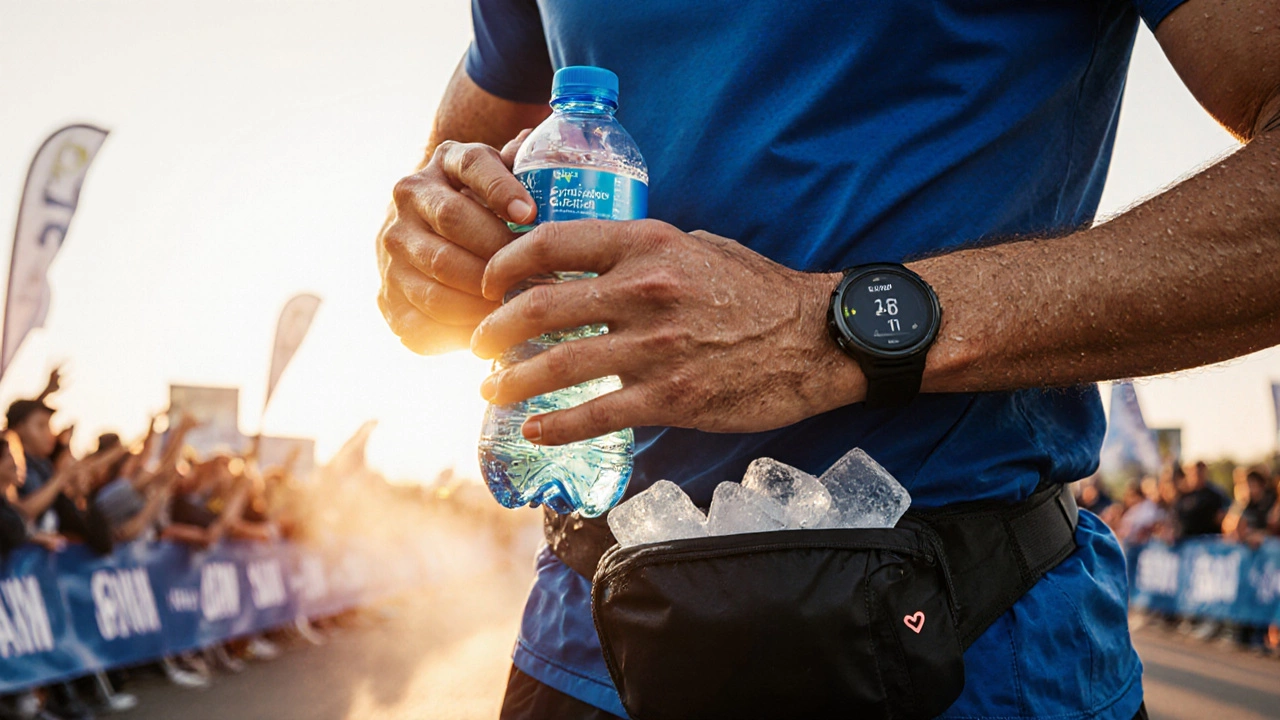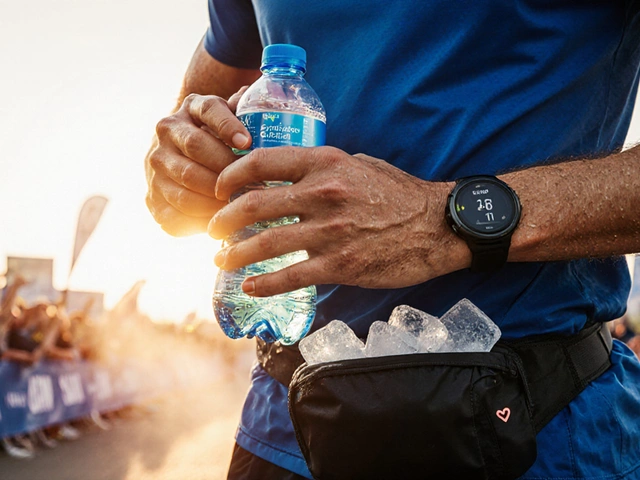48-Hour Post-Marathon Recovery Tracker
Recovery Timeline Overview
Understanding the key phases of your body's healing process after completing a marathon.
Key Recovery Actions
Essential steps to take during the first 48 hours to optimize your recovery.
Immediate Phase (0-2 Hours)
Your body begins the initial healing process immediately after finishing.
Recommended Actions:
First 24 Hours
Focus on replenishing energy stores and initiating muscle repair.
Recommended Actions:
24-48 Hours
Muscle repair and immune system reset occur during this phase.
Recommended Actions:
Important Recovery Factors
Sleep
Deep sleep triggers growth hormone release which accelerates protein synthesis and glycogen restoration.
Hydration
Continued fluid balance supports cellular functions; aim for pale yellow urine.
Warning Signs to Watch For
Sharp Pain
Pain that worsens after 48 hours may indicate injury requiring medical attention.
Swelling
Swelling that doesn't improve with gentle movement needs evaluation.
Systemic Symptoms
Dizziness, rapid heartbeat, extreme fatigue, or fever could signal serious issues.
Recovery Tips
Hydration: Drink 2-3 liters of fluid per hour post-race to replace sweat losses.
Nutrition: Prioritize high-glycemic carbs like bananas and potatoes for quick glycogen replenishment.
Activity: Light movement such as walking helps lower cortisol levels without overexertion.
Sleep: Aim for 8-10 hours of uninterrupted sleep to maximize recovery benefits.
Tracking Your Recovery
Keep track of:
- Hydration levels (urine color)
- Sleep duration and quality
- Pain levels and DOMS
- Energy levels throughout the day
- Heart rate variability trends
This data will help you adjust future recovery strategies and identify patterns.
Long-Term Recovery Benefits
Consistent post-marathon recovery routines lead to improved glycogen restoration and reduced DOMS over time. Incorporating strength training and mental recovery practices enhances overall resilience.
Crossing the finish line feels amazing, but the next 48hours are when your body really starts to heal. Understanding what’s going on under the skin helps you make smarter choices and bounce back faster.
Immediate Phase: 0‑2Hours After the Finish Line
Right after you stop running, your heart rate drops but stays above resting levels. Blood keeps pumping to deliver oxygen to fatigued muscles, and a surge of hormones like adrenaline and cortisol begins to recede.
Inflammation is the body’s natural response to muscle fiber micro‑tears, causing swelling, heat, and a mild ache. It peaks within the first hour and sets the stage for repair. Your immune system dispatches white blood cells to clean out debris, a process that feels like the familiar post‑run soreness.
During this window, rehydration is critical. Sweat loss can be 2‑3L, so sipping electrolyte‑rich fluids restores sodium, potassium, and magnesium, preventing cramping later.
First 24 Hours: Replenishing Energy Stores
Running a marathon depletes muscle glycogen the stored form of carbohydrate in muscle fibers that fuels endurance activity. Your body works overtime to refill those stores, especially in the first 12hours.
Eating a carbohydrate‑protein combo (about 3:1 ratio) within 30‑60 minutes boosts insulin, which helps shuttle glucose into muscles. A bowl of oatmeal topped with banana and a scoop of whey is a classic choice.
Protein intake supports the repair of damaged myofibrils. Aim for 20‑30g of high‑quality protein per meal for the next two days. This supplies the amino acids needed to rebuild the contractile units torn during the race.
Meanwhile, DOMS Delayed Onset Muscle Soreness, the dull ache that peaks 24‑48hours after intense exercise starts to set in. It’s a sign that the repair process is underway, not a red flag.
24‑48 Hours: Muscle Repair and Immune Reset
Between the second and third day, your body shifts from breaking down damaged tissue to rebuilding it. Satellite cells, a type of stem cell located on muscle fibers, activate and fuse to form new myofibrils.
Immune response the coordinated activity of white blood cells, cytokines, and acute‑phase proteins that clear debris and signal tissue repair begins to calm down. Elevated cytokine levels (like IL‑6) that were high right after the race start to drop, reducing systemic inflammation.
Heart rate variability (HRV) is a useful proxy for recovery. A rising HRV over these two days signals that the autonomic nervous system is rebalancing, indicating you’re moving back toward a rested state.

Sleep, Hydration, and Hormones: The Hidden Recovery Drivers
Quality sleep is perhaps the single most powerful recovery tool. During deep sleep, growth hormone spikes, accelerating protein synthesis and glycogen restoration. Aim for 8‑10hours of uninterrupted sleep each night.
Continued hydration maintaining fluid balance through water and electrolytes to support cellular functions is essential. Even after you feel “normal,” urine should be pale yellow, not dark.
Cortisol, the stress hormone, remains elevated for up to 48hours. Light activity-like a 20‑minute walk-helps lower cortisol more quickly than complete rest, while still respecting the need for recovery.
Practical Checklist for the First Two Days
| Action | When | Why It Helps |
|---|---|---|
| Consume electrolytes | Within 30min | Restores sodium/potassium lost in sweat |
| Eat carb‑protein snack (3:1) | 30‑60min post‑run | Kick‑starts glycogen refill and protein synthesis |
| Light walk or gentle stretch | 2‑6hr after finish | Promotes circulation, reduces stiffness |
| Cold‑water foot soak (10min) | Day1 evening | Temporarily eases inflammation |
| Prioritize 8‑10hr sleep | Night1 & night2 | Boosts growth hormone, HRV recovery |
| Second protein‑rich meal | Day2 breakfast | Continues muscle repair |
| Monitor HRV or resting heart rate | Morning of day2 | Tracks autonomic rebound |
| Gentle yoga or foam rolling | Day2 afternoon | Improves flexibility, reduces DOMS |
When to Seek Professional Help
If you notice any of the following, it’s time to talk to a health professional:
- Sharp, localized pain that worsens instead of eases after 48hours
- Swelling that doesn’t subside with gentle movement
- Persistent dizziness, rapid heartbeat, or extreme fatigue
- Fever or signs of infection (redness, warmth, pus)
These symptoms could signal stress fractures, severe tendinitis, or an infection-conditions that need targeted treatment.
Long‑Term Outlook: Turning Recovery into Future Gains
Every marathon provides a data point for your body. By logging how you felt during the 48‑hour window, you can fine‑tune nutrition, sleep, and training for the next race. Many runners notice that a consistent post‑race routine leads to faster glycogen restoration and less severe DOMS over time.
Incorporating regular strength training, especially eccentric work (like slow‑lowering squats), pre‑emptively strengthens the muscle fibers that usually tear during a marathon. This translates into a smoother recovery curve.
And don’t forget mental recovery. Journaling your race experience or spending time in a low‑stress environment helps the nervous system reset, making you feel refreshed as well as physically repaired.

Frequently Asked Questions
How soon can I run again after a marathon?
Most experts recommend at least a 5‑7day easy‑run period before resuming moderate mileage. Listening to your body-checking for pain, HRV trends, and energy levels-will give you a clearer cue.
Is ice bathing worth it for post‑marathon inflammation?
Cold immersion can temporarily reduce swelling and provide pain relief, but research shows it may also blunt some natural adaptive responses. A short 5‑10minute soak after the first day is a reasonable compromise.
What foods best replenish glycogen?
High‑glycemic carbs like white rice, potatoes, bananas, and sports drinks are most efficient within the first hour. Pair them with a protein source (e.g., yogurt, lean meat) for optimal recovery.
Can I take NSAIDs right after the race?
Occasional use of ibuprofen can help manage pain, but regular use may interfere with the inflammatory signaling needed for muscle repair. Use sparingly and preferably under medical advice.
How does sleep quality affect glycogen restoration?
During deep sleep, growth hormone release peaks, driving protein synthesis and glycogen synthase activity. Poor sleep can delay both processes, extending DOMS and fatigue.

